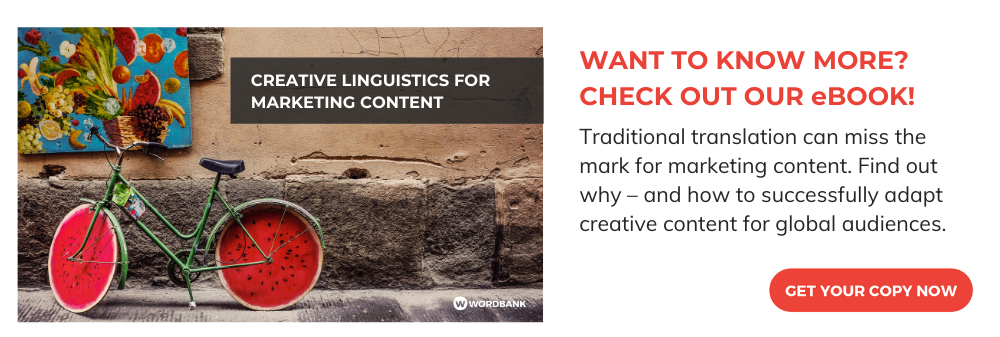Translation vs. localization vs. transcreation: What’s the difference?
July 28, 2020

July 28, 2020
The general goal of adapting any type of content for international audiences is to transform information and messaging from one language into another. But for marketers, adapting US-domestic content that drives engagement and inspires action across different languages, locales, and platforms can be complicated.
Part of the reason adapting marketing content can be so hard to get right is because of how the language service industry tends to operate.
When going global with their content, many companies search for translation services as an obvious starting point. But translation service delivery varies greatly, depending on how it’s approached – whether through the use of technology, human talent, or both. Translation “quality” often becomes a generic reference from language service providers (LSPs), defined by quality assurance (QA) processes and tools. For marketing content, these types of transactional QA solutions miss the point.
That’s because “quality” is subjective, not just from a linguistic perspective but from a brand and messaging experience perspective. Depending on the nature and purpose of marketing content, the goal may be to raise brand awareness, generate engagement, or drive conversions. For marketing content, translation quality is determined by its ability to achieve those goals.
Marketers need to align language services with the nature and purpose of their content. But sourcing translation and localization services they actually need – and balancing those against budget and goals – can be a challenge. And if the localized outcome is in a language (and for a culture) they don’t know, how can marketers be sure it’s written well and relevant to their audience?
Stakes are high, from wasted budget dollars to lost trust and negative impact on brand sentiment. Here’s what you need to know about transcreation vs. translation vs. localization – and how to determine what’s right for your content.
Translation is the transformation of content from one language into another so that the meaning of the original source is conveyed accurately and naturally.
It’s a term that people widely recognize and understand at a base level. The problem is that expectations vary widely about what the outcome of translation should be. And with free options (like Google Translate) and human translation available at a wide range of per-word rates, buying translation services can be a complex and sometimes risky process for organizations.
Translation services cover a broad range of effort and complexity:
However, most translation-buying processes heavily focus on per-word cost management, technology, and generic references to “quality.” So it can be hard for buyers to compare and select the right translation service.
Marketers frequently get feedback that their translated content is of poor quality, too literal, or not locally relevant. Why? Because marketing is about engagement and inspiring action. Local relevance and authentically localized messaging is key to its effectiveness.
Most LSPs talk about services using a one-size-fits-all, transactional approach. But they fail to understand the nature and purpose of marketing content in order to drive linguistic need. More often than not, the result is in-language content that misses the mark.
This approach leads to translated content that can be technically accurate but obviously translated, at best, and uninspiring and frustrating, at worst. The stakes are even higher in markets that are very competitive or have more developed economies or higher English proficiency. These local consumers will be less forgiving of sub-par translated content.
Many marketers struggling to get ROI from their marketing efforts must then seek out more creative linguistic solutions. And this often leads them to a search for “transcreation.”
“Many businesses miss the vital importance of engaging their global audience with content that resonates with them – not just with simple translation, but with a full language experience that conveys their brand, reputation, and trustworthiness.”
– Common Sense Advisory, “Can’t Read, Won’t Buy,” 2020

Transcreation is the adaptation of creative concepts so that your message, brand, and value proposition are conveyed in a locally authentic way. As a term in the industry, it denotes the level of human creativity required to adapt content for international audiences.
Transcreation is important for content that doesn’t readily “translate,” particularly for marketing messaging. Examples include advertising copy, taglines, product names, and content that’s heavily branded, includes US references, or involves English wordplay. Transcreation delivers engagement around your brand and messaging, with the goal of driving action and getting results.
Though the term is less known than translation, marketers usually understand “transcreation” immediately. Buyers have adopted this term, knowing that they need a more creative approach to language services.
When it comes to marketing, which is often highly creative in nature, a creative concept might not translate at all and may require a complete rewrite, which is where transcreation comes in. However, for creative content where concepts do readily translate, creative translation carried out by professional in-country linguists with a marketing background will do the trick.
This creative translation process looks, in many ways, like traditional translation. It’s sold by the word and involves multistage translation, edit, and proof processes. And, with the right skill and strategy, it can leverage computer-aided translation memory tools.
Whether marketing content requires creative translation or transcreation, the result should truly resonate with the local audience. It sounds like something written just for them, boosting brand credibility and sentiment.
Localization refers to a broader process of cultural adaptation related to the entire content experience. Translation and transcreation are the linguistic elements of localization. But localization also includes visuals, design, and other experience elements.
The more creative the content and the greater the need for concept adaptation, the more likely visual and design elements will also need to be adapted for an authentic, localized experience. In some cases, appropriate localization can mean copywriting and designing content from scratch to drive maximum in-market results.

Marketing content ranges from creative to informational, high-visibility to low-visibility, long-term to short-term. Each level of creative linguistic service lends itself to the nature and purpose of your content. Get it right and you maximize engagement and ROI. Get it wrong and you risk a costly mistake for both your budget and your brand.
Think of translation and transcreation as services at opposite ends of a range of linguistic solutions. Each has its own service variations and options in between. The key is to balance your content goals, your budget, and the quality you need to achieve those goals. This could mean that machine translation is the right solution for some elements, while transcreation or creative translation is a must for others.
To get this right, it’s crucial to understand that one-size-fits-all translation rarely hits the mark for marketing and creative content. A poor or mediocre translation – whether by machine or misaligned human translation – conveys the wrong message to your international audiences. Have a consultative dialogue with your localization partner about how to get the right level of creativity for your content without breaking your budget.
Your international customers may understand your translated content, but that’s not enough. Unless their experience of your in-language content is authentic across all media and platforms, they’re unlikely to feel connected to your brand or trust your product.